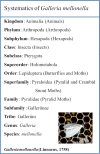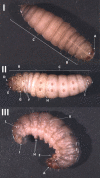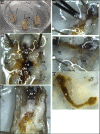The greater wax moth Galleria mellonella: biology and use in immune studies
- PMID: 32970818
- PMCID: PMC7683414
- DOI: 10.1093/femspd/ftaa057
The greater wax moth Galleria mellonella: biology and use in immune studies
Abstract
The greater wax moth Galleria mellonella is an invertebrate that is increasingly being used in scientific research. Its ease of reproduction, numerous offspring, short development cycle, and finally, its known genome and immune-related transcriptome provide a convenient research model for investigation of insect immunity at biochemical and molecular levels. Galleria immunity, consisting of only innate mechanisms, shows adaptive plasticity, which has recently become the subject of intensive scientific research. This insect serves as a mini host in studies of the pathogenicity of microorganisms and in vivo tests of the effectiveness of single virulence factors as well as new antimicrobial compounds. Certainly, the Galleria mellonella species deserves our attention and appreciation for its contribution to the development of research on innate immune mechanisms. In this review article, we describe the biology of the greater wax moth, summarise the main advantages of using it as a model organism and present some of the main techniques facilitating work with this insect.
Keywords: Galleria mellonella; host-pathogen interaction; insect immunity; insect model organism; life history.
© The Author(s) 2020. Published by Oxford University Press on behalf of FEMS.
Figures





Similar articles
-
Microbiology's next top model: Galleria in the molecular age.Pathog Dis. 2021 Feb 19;79(2):ftab006. doi: 10.1093/femspd/ftab006. Pathog Dis. 2021. PMID: 33476383 Review.
-
Utility of Greater Wax Moth Larva (Galleria mellonella) for Evaluating the Toxicity and Efficacy of New Antimicrobial Agents.Adv Appl Microbiol. 2012;78:25-53. doi: 10.1016/B978-0-12-394805-2.00002-6. Adv Appl Microbiol. 2012. PMID: 22305092
-
Fungal immunity and pathogenesis in mammals versus the invertebrate model organism Galleria mellonella.Pathog Dis. 2021 Mar 20;79(3):ftab013. doi: 10.1093/femspd/ftab013. Pathog Dis. 2021. PMID: 33544836 Free PMC article. Review.
-
The wax moth Galleria mellonella as a novel model system to study Enteroaggregative Escherichia coli pathogenesis.Virulence. 2017 Nov 17;8(8):1894-1899. doi: 10.1080/21505594.2016.1256537. Epub 2017 Oct 19. Virulence. 2017. PMID: 27824518 Free PMC article. No abstract available.
-
Methods for Using the Galleria mellonella Invertebrate Model to Probe Enterococcus faecalis Pathogenicity.Methods Mol Biol. 2022;2427:177-183. doi: 10.1007/978-1-0716-1971-1_15. Methods Mol Biol. 2022. PMID: 35619034
Cited by
-
Development of sensitizer peptide-fused endolysin Lys1S-L9P acting against multidrug-resistant gram-negative bacteria.Front Microbiol. 2023 Nov 23;14:1296796. doi: 10.3389/fmicb.2023.1296796. eCollection 2023. Front Microbiol. 2023. PMID: 38075915 Free PMC article.
-
Characterising phagocytes and measuring phagocytosis from live Galleria mellonella larvae.Virulence. 2024 Dec;15(1):2313413. doi: 10.1080/21505594.2024.2313413. Epub 2024 Feb 15. Virulence. 2024. PMID: 38357909 Free PMC article.
-
Nanoemulsion Increases the Antifungal Activity of Amphotericin B against Four Candida auris Clades: In Vitro and In Vivo Assays.Microorganisms. 2023 Jun 21;11(7):1626. doi: 10.3390/microorganisms11071626. Microorganisms. 2023. PMID: 37512799 Free PMC article.
-
Phenazine Cations as Anticancer Theranostics†.J Am Chem Soc. 2024 May 8;146(18):12836-12849. doi: 10.1021/jacs.4c03491. Epub 2024 Apr 29. J Am Chem Soc. 2024. PMID: 38683943 Free PMC article.
-
Morphological and Chemical Changes in the Hemolymph of the Wax Moth Galleria mellonella Infected by the Entomopathogenic Fungus Conidiobolus coronatus.Pathogens. 2025 Jan 7;14(1):38. doi: 10.3390/pathogens14010038. Pathogens. 2025. PMID: 39860999 Free PMC article.
References
-
- Altincicek B, Stötzel S, Wygrecka M et al. Host-derived extracellular nucleic acids enhance innate immune responses, induce coagulation, and prolong survival upon infection in insects. J Immunol. 2008;181:2705–12. - PubMed
-
- Anderson MA, Mignat EC. The number of larval instars of greater wax moth Galleria mellonella with characters for identification of instars. J Georgia Entomol Soc. 1970;5:65–8.
-
- Avila EE. Functions of antimicrobial peptides in vertebrates. Curr Protein Pept Sci. 2017;18:1098–119. - PubMed
Publication types
MeSH terms
Substances
LinkOut - more resources
Full Text Sources
Other Literature Sources

